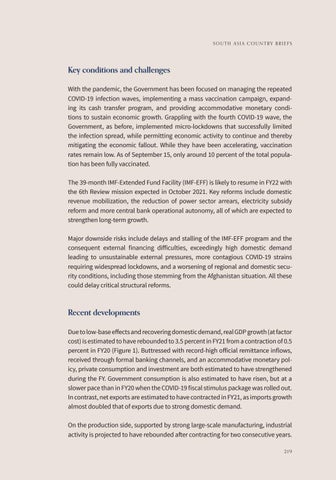S o u t h A s ia c o u n t r y b r i e f s
Key conditions and challenges With the pandemic, the Government has been focused on managing the repeated COVID-19 infection waves, implementing a mass vaccination campaign, expanding its cash transfer program, and providing accommodative monetary conditions to sustain economic growth. Grappling with the fourth COVID-19 wave, the Government, as before, implemented micro-lockdowns that successfully limited the infection spread, while permitting economic activity to continue and thereby mitigating the economic fallout. While they have been accelerating, vaccination rates remain low. As of September 15, only around 10 percent of the total population has been fully vaccinated. The 39-month IMF-Extended Fund Facility (IMF-EFF) is likely to resume in FY22 with the 6th Review mission expected in October 2021. Key reforms include domestic revenue mobilization, the reduction of power sector arrears, electricity subsidy reform and more central bank operational autonomy, all of which are expected to strengthen long-term growth. Major downside risks include delays and stalling of the IMF-EFF program and the consequent external financing difficulties, exceedingly high domestic demand leading to unsustainable external pressures, more contagious COVID-19 strains requiring widespread lockdowns, and a worsening of regional and domestic security conditions, including those stemming from the Afghanistan situation. All these could delay critical structural reforms.
Recent developments Due to low-base effects and recovering domestic demand, real GDP growth (at factor cost) is estimated to have rebounded to 3.5 percent in FY21 from a contraction of 0.5 percent in FY20 (Figure 1). Buttressed with record-high official remittance inflows, received through formal banking channels, and an accommodative monetary policy, private consumption and investment are both estimated to have strengthened during the FY. Government consumption is also estimated to have risen, but at a slower pace than in FY20 when the COVID-19 fiscal stimulus package was rolled out. In contrast, net exports are estimated to have contracted in FY21, as imports growth almost doubled that of exports due to strong domestic demand. On the production side, supported by strong large-scale manufacturing, industrial activity is projected to have rebounded after contracting for two consecutive years. 219




